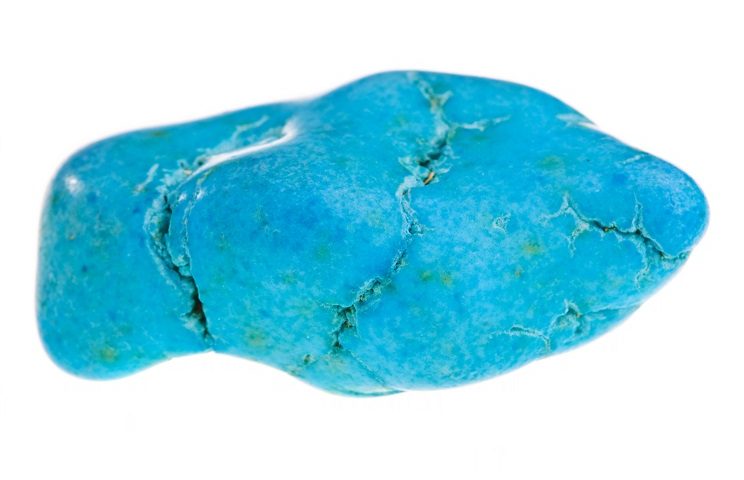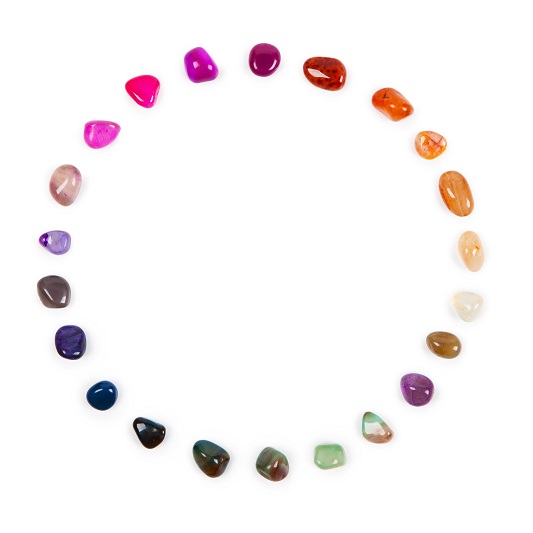Gem Silica – Gemstone of the Week

Strontium Titanate
15th June 2018
Why Do We Love Jewellery So Much
28th June 2018Known for its vivid blue-green colouring, Gem Silica is a variety of Chalcedony. The gemstone receives its unique colouring from the presence of Copper in its composition. The higher the level of Copper, the more vibrant the colouring. Though the formal name for the stone is ‘Gem Silica’, it is often referred to as ‘Chrysocolla Chalcedony’ or ‘Gem Silica Chrysocolla’.
Today, Gem Silica is one of the most valuable varieties of Chalcedony. When cut and polished, the stone can sell for as much as £100 per carat. Like most gemstones, the specimens with strong colour saturation sell for the highest price. A uniform translucence and lack of inclusions also add to the value of the speci-men. Despite the beautiful appearance of the gem, it is rarely seen in gemstone jewellery due to its rari-ty. With this in mind, designer jewellery that does include Gem Silica carries a hefty price tag. In this arti-cle, we explore Gem Silica in more detail.
How to Identify Gem Silica
Although the stone is rare, professionals can identify Gem Silica with ease. As one of the few gemstones that contain Copper, the stone can sometimes be identified by this alone. As the stone is similar in ap-pearance to Turquoise, the two can sometimes be confused. However, Gem Silica can be distinguished by its soft hardness. Unlike Turquoise, Gem Silica has a hardness of around 3 on the Mohs scale. The stone can also be identified by its chemical composition. In addition to the inclusion of Copper, Gem Silica is often found mixed with Quartz, Azurite, and Malachite.
Different Colours and Types of Gem Silica
Gem Silica is colourless Chalcedony that has been coloured by the inclusion of Copper salts. Though all specimens of Gem Silica are bluish-green, the saturation varies between stones. The more Copper in the stones composition, the more vivid the colour. High-quality specimens are translucent to transparent with a vivid colour. The colour of high-quality stones should be consistent with good clarity.
Due to the unusual conditions that Gem Silica needs to form, high-quality specimens are very rare. While regular Chalcedony is sold for around £3 per carat, top-quality Gem Silica can go for as much as £100 per carat. As true Gem Silica jewellery is seldom found, many buyers purchase Chrysoprase jewellery, in-stead. A vivid green variety of Chalcedony, Chrysoprase has a similar appearance to Gem Silica but it much more affordable.
In the gemstone trade, Gem Silica is often known as ‘Chrysocolla Chalcedony’ and ‘Gem Silica Chrysocol-la’. This is because the bluish-green colour of the stone can be related to Chrysocolla. While most people attribute the colour of the stone to Copper salts, others believe that the blue-green colouring is caused by small inclusions of Chrysocolla in the stone, instead. Those in the gem trade that attribute the colour to Chrysocolla often refer to the stone as ‘Chrysocolla Chalcedony’ as opposed to ‘Gem Silica’.
Like most gemstones, Gem Silica can undergo a variety of treatments to improve its appearance. For in-stance, the colour of the gem can be enhanced by placing it in water. As the material is porous, the stone easily absorbs liquids. However, the enhanced colour is usually temporary when using this method. Occa-sionally, clear Chalcedony is dyed and sold as Gem Silica. While trained professionals can identify imposter Gem Silica from the real thing, it can appear almost identical to the untrained eye. If you’re hoping to pur-chase Gem Silica, it’s best to visit a trustworthy dealer to ensure you get the real deal.
Where is Gem Silica Found?
As mentioned previously, Gem Silica is incredibly rare. With this in mind, there are only a few locations that produce noteworthy amounts of the mineral. As Gem Silica deposits are often small, many locations are exhausted after just a few years.
Typically, Gem Silica is found with Copper deposits. The mineral forms as a secondary stone in rocks adja-cent to Copper deposits. Occasionally, Gem Silica can occur as a mineral lining in Geodes, too. Like most varieties of Chalcedony, Gem Silica is often associated with Quartz, Chrysocolla, and Malachite.
Today, most high-quality Gem Silica is sourced from the Miami-Inspiration Mine in Arizona. In the 1900s, notable amounts of the stone were also found in the Keystone Copper Mine in Arizona, though this source has now been exhausted. Smaller deposits of the gem are still found in Mexico, Peru, Taiwan, the Philippines, and New Mexico.
Healing Properties of Gem Silica
Like most gemstones, Gem Silica boasts a range of healing properties. The stone is best known for its calming effects. With this in mind, it is beneficial for those suffering from nervous disorders such as anxie-ty and depression, as well as feelings of guilt. The gem can also be used to reduce menstrual discomfort and promote healthy pregnancies. First-time mothers can also use the stone to relieve anxiety associated with childbirth and parenting.
Physically, Gem Silica can be used to aid digestion and combat digestive issues such as IBS, IBD, and Crohn’s Disease. The stone can also relieve pain associated with the hips. With this in mind, it is popular amongst those suffering from arthritis, rheumatism, and those that have undergone a hip replacement. Wearing the stone around the neck can strengthen the muscles and reduce muscle cramps. Additionally, Gem Silica can prevent infections, reduce fever, and relieve pain associated with burns.
In Summary
High-quality Gem Silica is popular worldwide. Today, most high-quality specimens are sourced from the Miami-Inspiration Mine in Arizona, though smaller deposits are also found in Mexico, Peru, Taiwan, and the Philippines. Loved for its vivid blue-green colouring, high-quality Gem Silica can sell for over £100 per carat. Whether you’re hoping to use the stone for its benefits within crystal healing or you’re looking for a beautiful new addition to your jewellery collection, purchase a piece of Gem Silica to reap the benefits.




